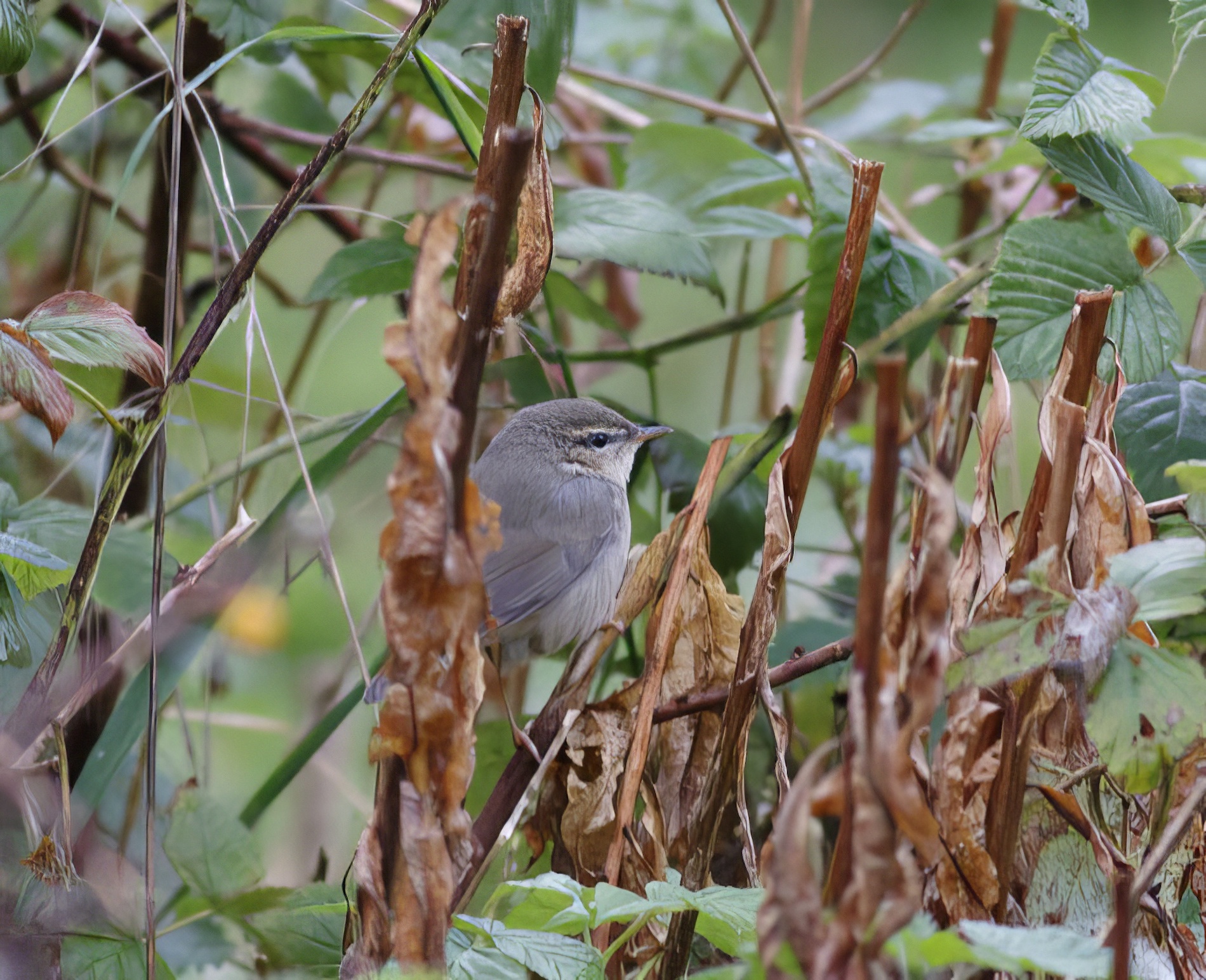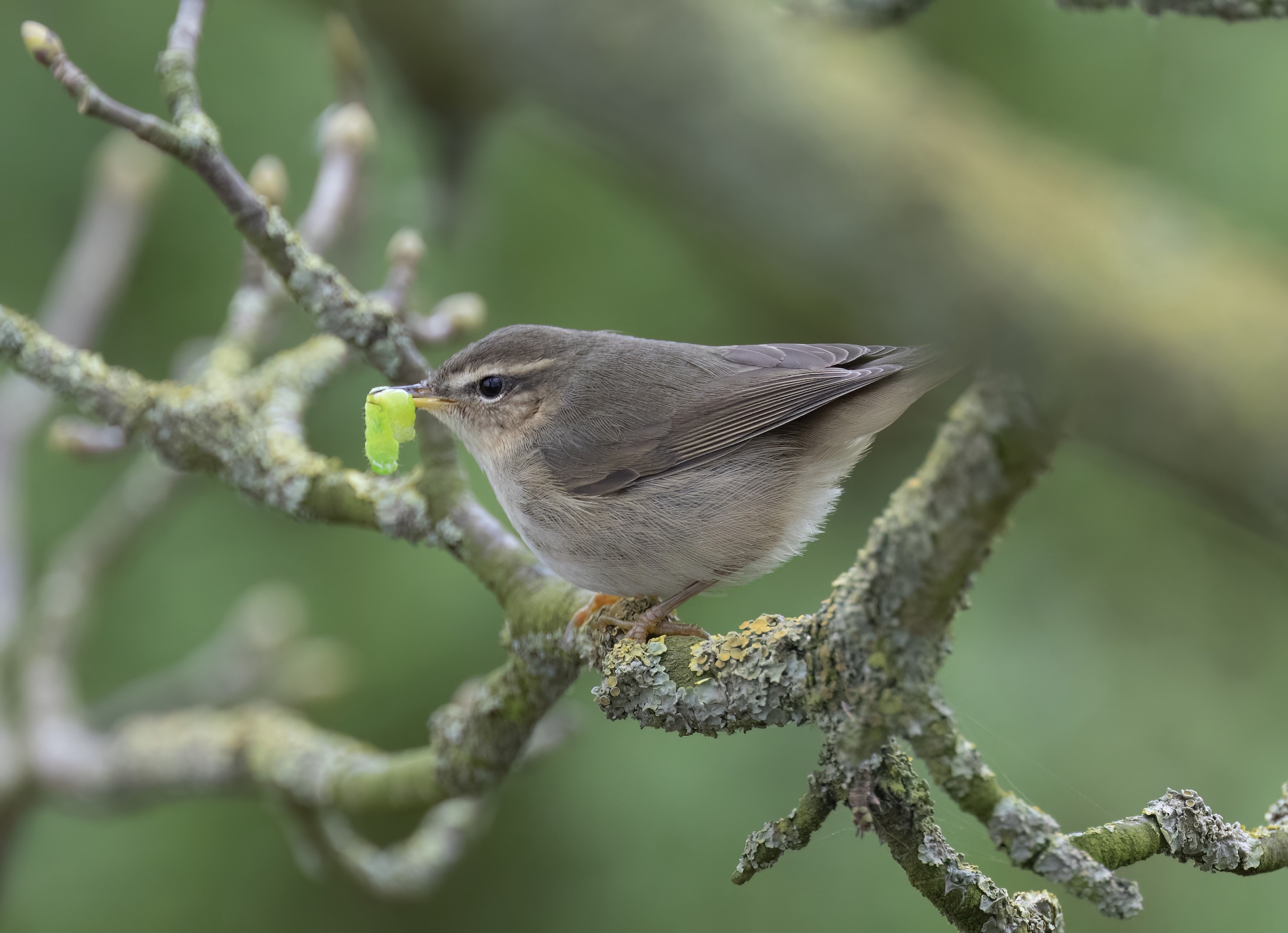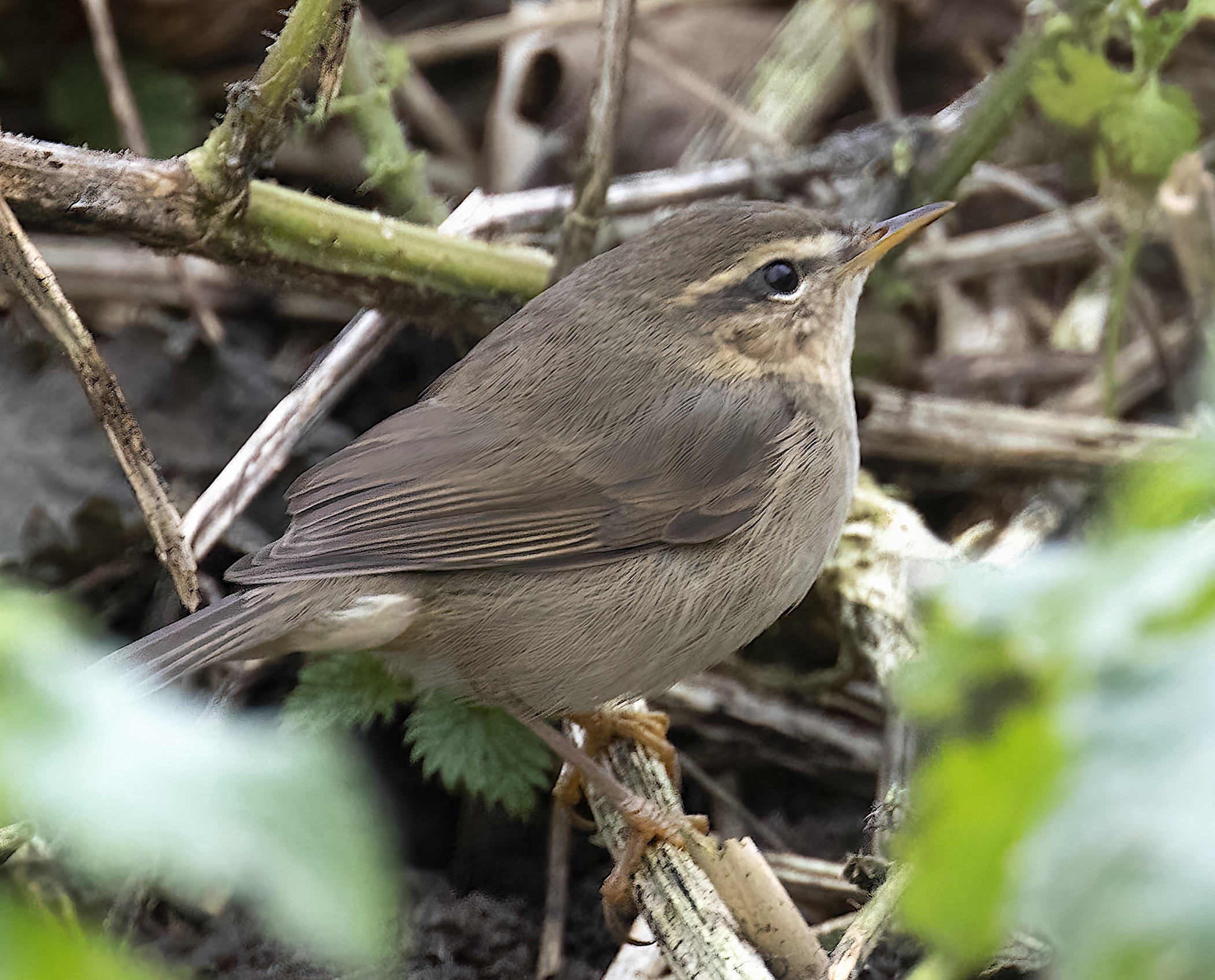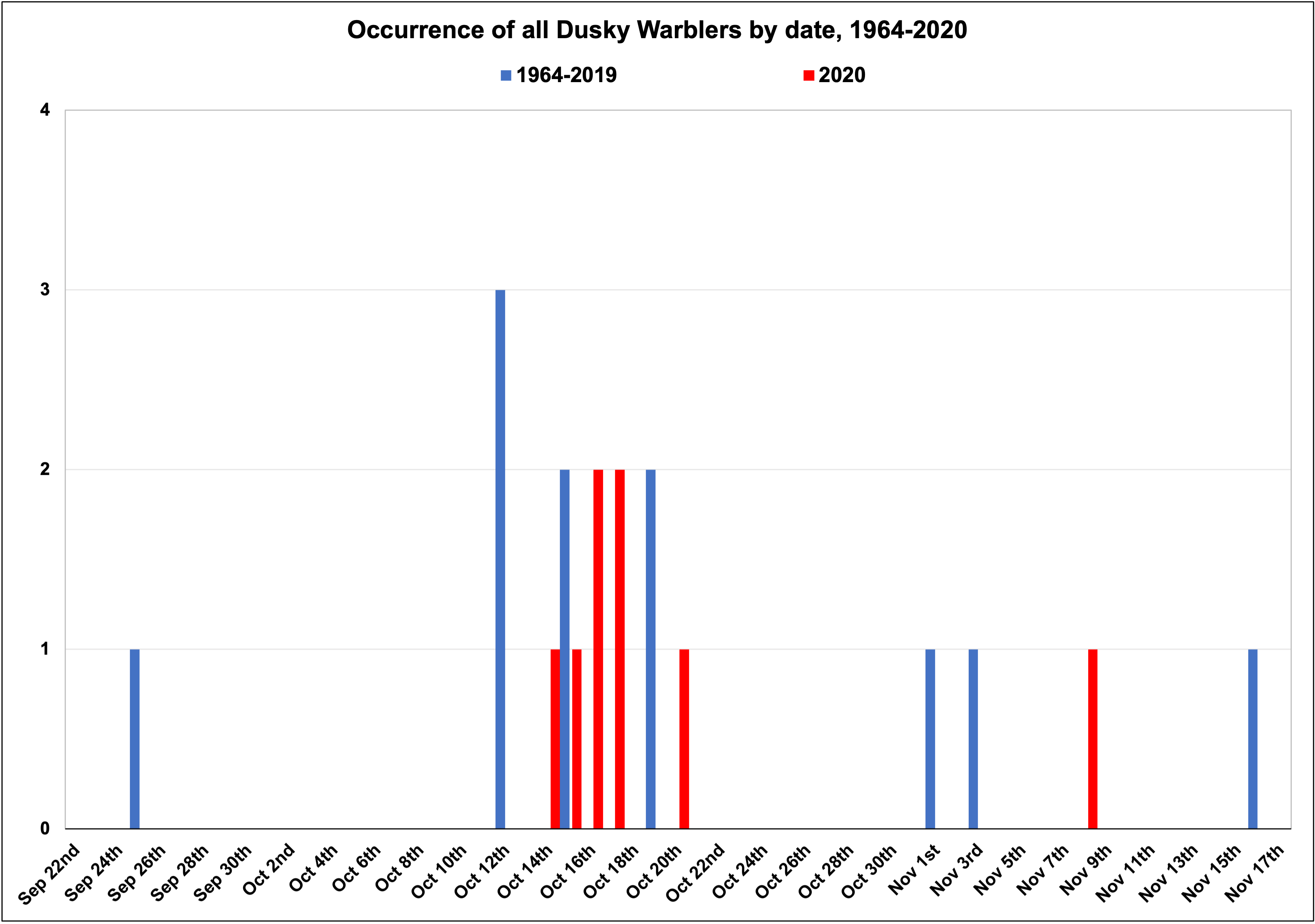Dusky Warbler Phylloscopus fuscatus
Rare. Siberia.



Dusky Warblers: left, Gibraltar Point October 15th 2016; centre and right, Wolla Bank, January 2019 (Graham Catley).
One ringed at Huttoft in November 1964 was the first county record. There have been 15 more records involving 12 birds, six of which were trapped and ringed. This is a similar picture to its close congener, Radde’s Warbler, P. schwarzi, also a skulking Bush Warbler and just as likely to be trapped as seen. The earliest bird in the autumn arrived on September 25th, 2001, the only September record, and the latest November 16th, 2019. The longest stay concerned a wintering bird found at Huttoft Bank on January 1st, 2019, remaining in the area until February 2020 at least. It is fair to assume that it had arrived there or somewhere nearby on the Lincolnshire coast in autumn 2018 remaining undiscovered until New Year’s Day listing got underway in January 2019. More remarkable perhaps was the discovery of another bird by the same observer at nearby Anderby Creek in November 2019, although 2020 provided a bigger surprise when there were nine accepted records (see summary below). These were part of a countrywide invasion when there were 110 accepted records (White and Kehoe 2022). As with Radde’s Warbler, P. schwarzi, Dusky Warbler ceased to be a species considered by BBRC in 2006. White and Kehoe (2022) reported that the total number of British records 1958-2020 was 717. The annual average number of records rose from 13 during 1990-1999 to 26 in 2010-2019, although the report adds that the annual variability during 2000-2020 was very high.
The invasion in autumn 2020
In 2020 there was a minimum of nine accepted records, seven of them arriving between October 14th-20th with two later ones in November and December : Saltfleetby-Theddlethorpe October 14th-17th; Saltfleet Oct ober 15th; Gibraltar Point October 16th-19th; Seaview Farm, Saltfleetby-Theddlethorpe NNR October 16th-18th; Donna Nook October 17th-18th; North Cotes October 17th; Wolla Bank Pit, Anderby October 20th; Goxhill Haven November 8th; Donna Nook December 5th.
Prior to 2020, 1964-2019, there had been just 12 records with seven of those since 2000, so with the nine in 2020 the total now stands at twenty. The arrival dates (all years combined) are plotted below. The earliest autumn arrival date was September 25th, 2001. Most arrived October 12th-20th(14) with four in November (1st, 3rd, 8th, and 16th) and an even later one on December 5th in 2020; it is a moot point as to whether the latter bird was a very late autumn arrival or had arrived earlier and was wintering (though it wasn’t seen after December 5th). The sole January record was of a well-watched over-winterer found on January 1st, 2019, and present until February 3rd, 2019, at least.

(Note: the record of December 5th 2020 has been omitted from the chart for reasons of space.)
Finder’s report: Dusky Warbler at Huttoft Bank, November 1st, 1964, first county record.
by J. F. Cooper.
Note: this account is taken from the submission to the rarities Committee. Although most of the committee found this record acceptable when it was originally considered in 1964, it was rejected then, under the minority rule, as a detailed wing formula had not been taken. At the request of the observer, however, the record was reconsidered and it is accepted on the plumage description. This became only the 4th British record at the time.
Circumstances
As I was extracting passerines from a mist-net at Huttoft Bank I heard strange call note not unlike a Sylvia ‘tic’ but softer and not so metallic. I then went to find the bird but could only obtain a brief view of a dark, drab Phylloscopus warbler with a noticeable eye stripe. The bird was extremely skulking, staying in the middle and towards the bottom of a small Buckthorn and Elder clump of bushes, which extended up to the mist-net. It was calling a single ‘tic’ note the majority of the time and would only stop when I tried to flush it. The call and the skulking behaviour suggested that it was a strange Phylloscopus sp. I then tried to drive it into the mist-net but could not flush it and the bird then became quiet for 5 minutes.
When the bird resumed calling, I went to find D. R. Cooper to help me to try to catch the bird. It was still calling when we returned but it was again elusive, and we could not see it. All the time we were looking for it, it was calling continuously. The call itself, sometimes only once before a brief pause but at other times it was repeated 3-4 times before a pause. We then tried to drive the bird into the net but somehow it escaped us. We next saw the bird in flight. The flight appeared to be more direct than other species of Phylloscopus. Another drive was successful, and the bird was caught, and the following description taken.
Description
The most striking features when the bird was in the hand were the dark brown plumage, whitish eye stripe and the yellow feet. It once called in the hand making a quiet and soft double call note, hard to describe and not at all like the note first heard in the field or like any note I have heard before. When released the flight didn’t appear so direct, it made straight to a clump of Buckthorn, where it stayed for about ½ a minute before dropping to the ground and out of sight. The bird was then left alone.
Upperparts – back, rump, tail and wings were uniform dark brown. The crown was similar. A conspicuous creamy eyestripe started at the base of the bill and became creamier above the ear coverts. Lores were a greyish-brown which also extended to behind the eye. Cheeks were buff with brown mottling.
Underparts – throat off white, breast dirtier with a brownish tinge becoming lighter on the lower breast and belly with one or two faint yellow streaks. Flanks were a greyish-brown, undertail coverts buffish, underwing light.
Bare parts – upper mandible brownish-black. Lower mandible similar from tip becoming yellowish towards base. Legs reddish-brown, feet were bright yellow on soles and a darker yellow on top of the toes. Eyes dark brown.
Biometrics - wing 53 mm., tail 46 mm.
Wing formula – emarginated 6th, longest primary 4th; 2nd 8 mm. shorter, 3rd 2 mm., 5th just shorter than 4th, 6th 1.5 mm., 7th 3.5 mm., 8th 5 mm., 9th not measured.
Reference
White, S. and Kehoe, C. (2022). Report on scarce migrant birds in Britain in 2020 Part 2: passerines. British Birds 115 (8): 427-451.
(Account as per new Birds of Lincolnshire (2021), included October 2022)

